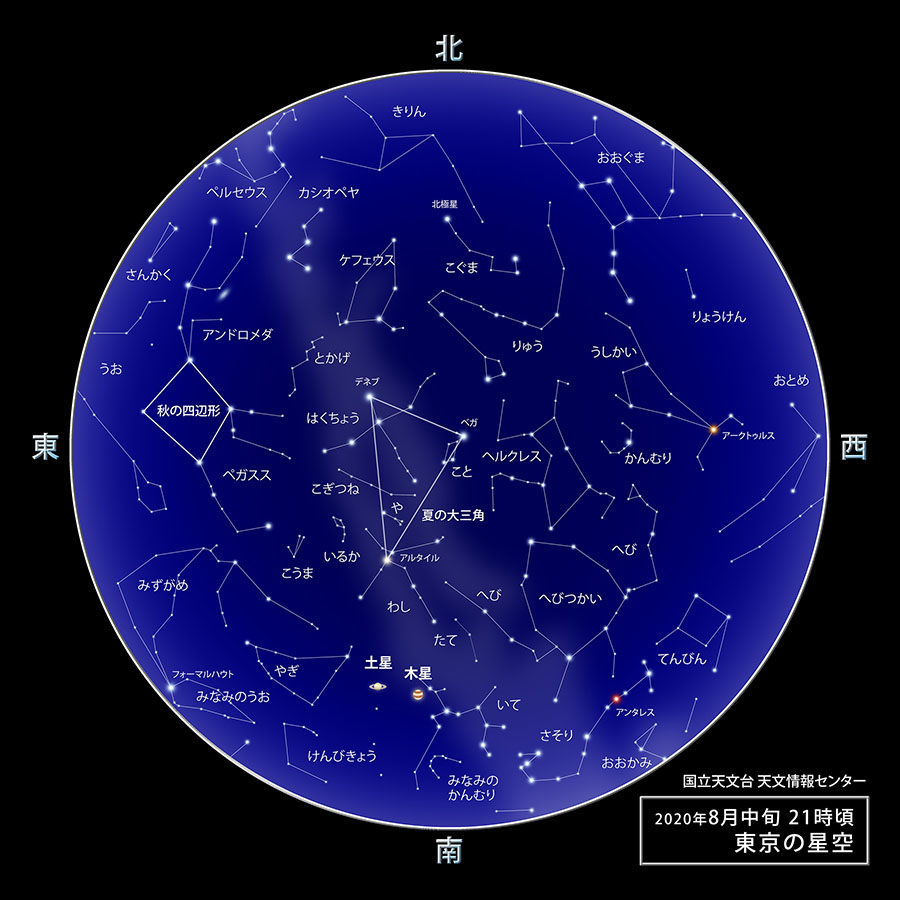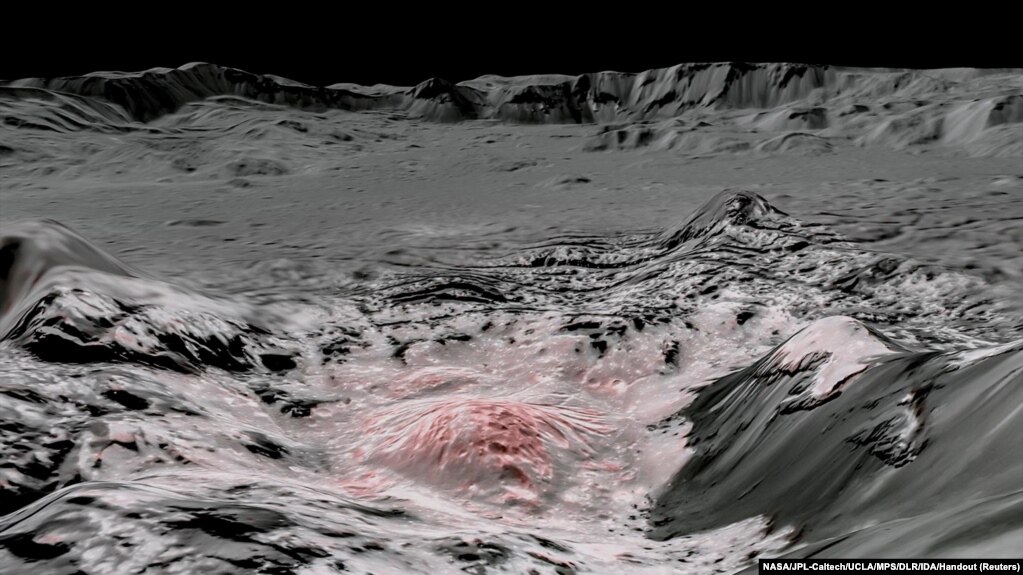Where is Ceres!?
今年8月12日22時ころに最大を迎えると予想されたペルセウス座流星群、みなさんはご覧になれましたか?
今年は8月12日が下弦のため、流星群を観察しやすい時間帯のほとんどに月明かりがあり、見える流星の数は条件の良い年より少ないだろうといわれていたのですが、私はあいにく見れず、友達が撮った写真で満足しました。
今月の星空(国立天文情報センターより)

今日のVOAニュースはDwarf Planet Ceres !!
いざ、宇宙の旅へ !!!
準惑星セレスの地下深くには塩分を含んだ海が存する
Dwarf Planet Ceres Has Salty Ocean Deep Underground
セレスは、Mars 火星と Jupiter木星の間にある小惑星帯(矮惑星帯または矮小惑星帯)の中で最大の天体です。新しい研究では、科学者たちは、この準惑星の冷たい表面の下に塩分を含んだ大きな水があることを示唆しています。
研究者たちは、セレスを”海の世界”、つまり生物をサポートするための適切な条件を持っている可能性がある場所と表現しています。
この研究は今月初め、Nature Astronomy誌、Nature Geoscience誌、Nature Communications誌に発表されました。
この研究は、2018年にセレスの地表まで35kmも接近して飛行したNASAの探査機ドーンが収集したデータに基づいています。この研究は、準惑星が地学的に活発なクライオヴォカニズム、つまり氷の物質を生み出す火山が残っていることを示す証拠を提供しているのです。
科学者たちは、彼らの発見が、ゆっくりと凍結している表面下の塩分を含んだ水の貯水池の存在を確認したと述べています。惑星科学者であり、ドーンの主任研究員であるキャロル・レイモンド氏はロイター通信に、液体が準惑星全体を覆っていないにもかかわらず、セレスを海の世界にしているのは、この発見のおかげだと語ってれました。
「ケレスの場合、液体貯留層が地域的な規模であることは分かっていますが、それが惑星全体の規模であることは確かではありません。しかし、最も重要なのは、大規模な液体があるということです」とレイモンド氏は話します。
セレスの周囲は約950キロ。科学者たちは、約2200万年前に大きな物体がケレスに衝突したときに形成された、幅92キロのクレーターを中心に研究を進めました。クレーターには、表面に達した液体からの塩の採取によって引き起こされた2つの明るい領域があります。
科学者たちによると、この液体は、地表から約40km下にある幅数百kmの塩水の貯水池から始まったといいます。大きな物体がセレスに衝突したときに、矮小惑星の表面に裂け目ができ、塩分を含んだ水が逃げ出すための開口部ができました。
地球以外にも、少なくとも地表の下に海があると思われる太陽系の天体がいくつかあります。木星の月エウロパ、土星の月エンケラドゥス、海王星の月トリトン、冥王星などです。
水は、生命にとって大事なものと考えられています。科学者たちは、セレスに微生物が住んでいたかどうかを研究したいと考えているのです。
NASAのジェット推進研究所の惑星科学者ジュリー・キャスティロ氏は、セレスの貯水池に生命が存在する可能性を調べることに、現時点で大きな関心があると述べています。”寒くて塩分が豊富に含まれていることを考えれば” まさにその通りである、と彼女は付け加えています。
惑星の定義:Draft planet
☟国立天文台より
https://www.nao.ac.jp/faq/a0508.html
2年近い討議と7名の特別委員会での検討がなされ、今年、3年に一度開かれる国際天文学連合(IAU)の総会で、惑星の定義についての決議がおこなわれました。
2006年8月14日から25日までチェコのプラハで開かれていた国際天文学連合の総会で、「惑星の定義」が採択されました。
国際天文学連合決議:太陽系における惑星の定義
現代の観測によって惑星系に関する我々の理解は変わりつつあり、我々が用いている天体の名称に新しい理解を反映することが重要となってきた。このことは特に「惑星」に当てはまる。「惑星」という名前は、もともとは天球上をさまようように動く光の点という特徴だけから「惑う星」を意味して使われた。近年相次ぐ発見により、我々は、現在までに得られた科学的な情報に基づいて惑星の新しい定義をすることとした。
決議5A
国際天文学連合はここに、我々の太陽系に属する惑星及びその他の天体に対して、衛星を除き、以下の3つの明確な種別を定義する:
- 太陽系の惑星(注1)とは、(a)太陽の周りを回り、(b)十分大きな質量を持つので、自己重力が固体に働く他の種々の力を上回って重力平衡形状(ほとんど球状の形)を有し、(c)自分の軌道の周囲から他の天体をきれいになくしてしまった天体である。
- 太陽系のdwarf planetとは、(a)太陽の周りを回り、(b)十分大きな質量を持つので、自己重力が固体に働く他の種々の力を上回って重力平衡形状(ほとんど球状の形)を有し(注2)、(c)自分の軌道の周囲から他の天体をきれいになくしておらず、(d)衛星でない天体である。
- 太陽の周りを公転する、衛星を除く、上記以外の他のすべての天体(注3)は、small solar system bodiesと総称する。
注1:惑星とは、水星、金星、地球、火星、木星、土星、天王星、海王星の8つである。
注2:基準ぎりぎりの所にある天体をdwarf planetとするか他の種別にするかを決めるIAUの手続きが、今後、制定されることになる。
注3:これらの天体は、小惑星、ほとんどのtrans-Neptunian object、彗星、他の小天体を含む。
国際天文学連合決議:冥王星
決議6A
国際天文学連合はさらに以下のように決議する:
冥王星は上記の定義によってdwarf planetであり、trans-Neptunian object天体の新しい種族の典型例と認められる。
※冥王星・セレス・2003UB313はdwarf planetですが、dwarf planetは惑星ではありません。dwarf planetは今後の観測によって増える可能性がありますが、惑星が増える可能性は低いでしょう。
Dwarf Planet Ceres Has Salty Ocean Deep Underground
 Mosaic image using false color to highlight the recently exposed brine, or salty liquids, that were pushed up from a deep reservoir under the crust of the drawrf planet Ceres.
Mosaic image using false color to highlight the recently exposed brine, or salty liquids, that were pushed up from a deep reservoir under the crust of the drawrf planet Ceres.
Ceres is the largest object in the asteroid belt between the planets Mars and Jupiter. In a new study, scientists suggest this dwarf planet contains a large body of salty water under its cold surface.
The researchers describe Ceres as an “ocean world” - a place that could have the right conditions to support living organisms.
The study was released earlier this month in the publications Nature Astronomy, Nature Geoscience and Nature Communications.
The research is based on data gathered by NASA’s Dawn spacecraft, which flew as close as 35 kilometers to the surface of Ceres in 2018. The study provides evidence that the dwarf planet remains geologically active with cryovolcanism - volcanoes that produce icy material.
The scientists say their findings confirm the presence of a reservoir of salty water below the surface that has been slowly freezing. Planetary scientist and Dawn lead investigator Carol Raymond told the Reuters news agency it is this finding that makes Ceres an ocean world, even though liquid does not cover the whole dwarf planet.
“In the case of Ceres, we know the liquid reservoir is regional scale but we cannot tell for sure that it is global. However, what matters most is that there is liquid on a large scale,” Raymond said.
Ceres is about 950 kilometers around. The scientists centered their work on a 92-kilometer-wide crater formed when a large object hit Ceres about 22 million years ago. The crater has two bright areas caused by salt collections from liquid that reached the surface.
The scientists say the liquid started in a salt water reservoir hundreds of kilometers wide about 40 kilometers below the surface. When the large object crashed into Ceres, breaks in the dwarf planet’s surface created openings for salty water to escape.
There are several other solar system bodies beyond Earth where there at least appear to be oceans below the surface. These include Jupiter’s moon Europa, Saturn’s moon Enceladus, Neptune’s moon Triton and the dwarf planet Pluto.
Water is considered a major necessity for life. Scientists want to study whether Ceres was ever home to microbial life.
Planetary scientist Julie Castillo of NASA’s Jet Propulsion Laboratory said there is major interest at this point in examining the possibility of life in Cerer’s reservoir. That is especially true “considering it is cold and getting quite rich in salts,” she added.
_______________________________________________________________
Words in This Story
asteroid belt – n. a gathering of any one of thousands of small planets that circle around the sun
dwarf planet – n. an object in space that looks like a small planet but lacks certain technical qualities that are required for it to be classed as such
geologically – adv. in a way that relates to rocks, land, or processes of land formation
reservoir – n. a place where a liquid is stored
regional – adj. a part of a country or world that is different or separate from other parts in some way
scale – n. the size or level of something especially in comparison to something else
global – adj. involving the entire world
crater – n. a large round hole in the ground made by the explosion of a bomb or by something falling from the sky
microbial – adj. an extremely small living thing that can only be seen with a microscope
quite – adv. to a very noticeable degree or extent